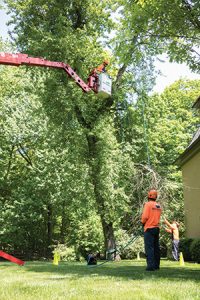
When most people think climate change, they think rising temperatures and melting glaciers. However, that’s not the only effect we’ve already started to see. Higher temperatures mean increased evaporation, which leads to heavier precipitation, stronger storms, higher winds, and an increased rate of storm damage to trees and property.
As we head into the fall, it’s smart to wonder about the trees on your property. Many tree weaknesses aren’t visible from the outside and take special equipment and expertise to diagnose. Even those that are obvious, like dead or hanging branches, require some experience and know-how to deal with safely. Here are a few of the best ways to protect your property
Pruning. Pruning your trees on a regular basis does more than just help them look their best. It gives experts a chance to identify the dead and dying branches that often cause damage in storms. Pruning also helps reduce a tree’s wind resistance, giving it a fighting chance in high winds.
Cabling and bracing. Even when a tree has some structural weaknesses, we look for ways to preserve it rather than take it down. One of the best options available for staving off major breakage is using cables and bracing rods to provide supplemental structural support and minimize movement in high winds. These are often necessary for older trees or trees that have dual trunks.
Lightning protection. Particularly large or well-established trees have a lot to add to your property in terms of shade and beauty. Unfortunately, these are the very trees that often get the worst of it in storms. A lightning protection system increases the odds that your tree will survive a strike and thrive for years to come.





